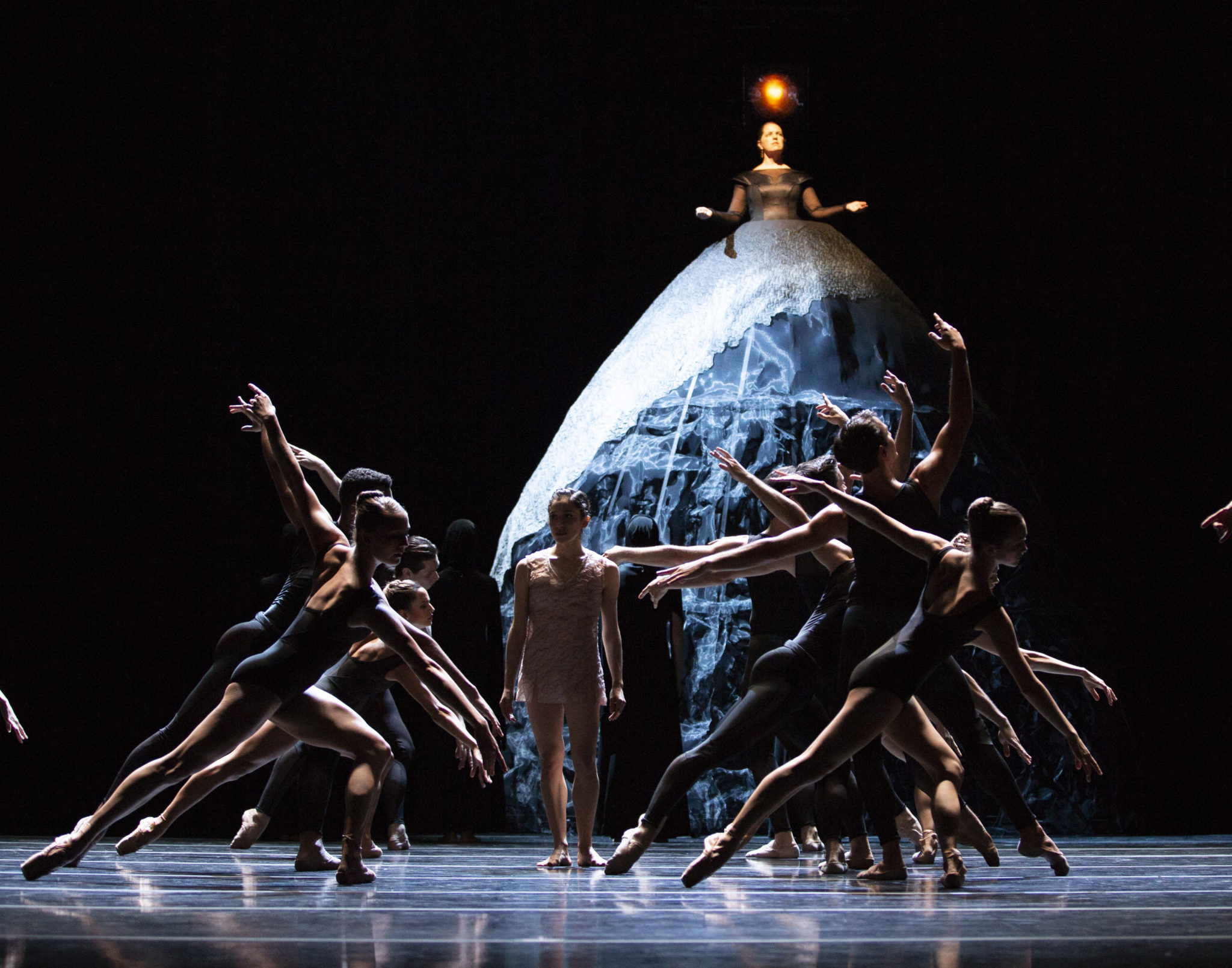
PNB dancer Leta Biasucci (center), soprano Christina Siemens, and company in A Dark and Lonely Space. Photo © Angela Sterling c/o PNB.
All Premiere is the second program of Pacific Northwest Ballet’s 2018-2019 season. Like Director’s Choice, you can count on All Premiere to feature some of the most interesting and innovative contemporary ballet available. This year started out with a (big) bang: Kyle Davis’ A Dark and Lonely Space.
A Dark and Lonely Space
Music: Michael Giacchino (Jupiter Ascending Symphony, 2013-2015, rev. 2017)
Choreography: Kyle Davis
Scenic and Lighting Design: Reed Nakayama
Costume Design: Elizabeth Murphy
Duration: 45 minutes
World Premiere: Pacific Northwest Ballet November 2, 2018
I mentioned in my last post that the name is a bit ironic, given the collaborative and home-grown nature of the production. The title is also a little bit misleading. You’d expect it to be a melancholy, introverted sort of piece with that name. But the dark and lonely place referenced in the title is actually space.
Big Bang
Composer Michael Giacchino wrote the music for the 2015 Wachowski sisters’ movie Jupiter Ascending. I haven’t seen it, and by all accounts it wasn’t very good, but the music is epic. Rather than dealing with space princesses, as the movie does, Davis does the soundtrack justice in scope. He imagines the birth of a new star system.

PNB dancer Leta Biasucci (center), soprano Christina Siemens, and company in A Dark and Lonely Space. Photo © Angela Sterling c/o PNB.
I can appreciate subtlety, but it’s not really my native language. A Dark and Lonely Space speaks my language. It’s not just the theme that’s cosmic in scale. Everything about this ballet is big. There’s a full cast of dancers and 125 musicians performing the music. Besides the full orchestra in the pit, the 60-some singers of the Pacific Lutheran University Choral Union fill the auditorium’s box seats. Soloist soprano Christina Siemens hovers over the stage like a goddess or a sentient sun.
A Fire Upon the Deep
Coincidentally, a few days before attending All Premiere, I finished reading Vernor Vinge’s book A Fire Upon the Deep. That book places a standard space adventure within a meditation about the limitations of the human mind in coping with the vastness of space. It imagines divinity as merely sentience that operates at a speed and scale that can accommodate that kind of immensity. This ballet, in anthropomorphizing space itself, felt like a continuation of that exercise in comprehending existence across orders of magnitude in scale.
Neverending Story
Perhaps because I was already thinking about stories that defy the scope of human imagination, I didn’t feel as compelled as usual to impose a strict narrative on the action. I could relax into the experience and just accept that everything was very, very big. The actual choreography helped, too. Sometimes we talk about writing as being transparent, meaning that instead of thinking, “What a lovely sentence,” we are so absorbed in the content that we aren’t aware of the delivery. Davis’ choreography was transparent in that way.
Leta Biasucci emerges like the pupa in Crystal Pite’s Emergence; once “hatched” she moves more like a spindly-legged newborn fawn than an insect. What you really notice though, is that she is smaller and more vulnerable than all the other very big things. The duo of Seth Orza and Noelani Pantastico are as sharp and pointy as Odile, but what registers is their disinterested threat to Biasucci’s survival. She flees them, but later mimics their movements, trying to figure out her own place in the system. Four dancers in black robes seem to provide tech support like a galactic version of the Ita in Neal Stephenson’s Anathem.
Space
Davis may be new to choreographing for the main stage, but he’s clearly ready to take up that much space. Without being too specifically referential, A Dark and Lonely Space reminded me of epic works like Emergence, Carmina Burana, Prodigal Son and State of Darkness. Like that last one, A Dark and Lonely Space automatically feels a little bit bigger because it deals with an infinite topic – space.
It’s odd that the infinite should feel particularly timely. Maybe it’s because the first interstellar object ever spotted in our solar system is about to leave us. Maybe it’s just me, and a coincidence that I read Anathem and Fire Upon the Deep and saw the movie Arrival in the last year. Or maybe global politics is such a garbage fire we’re all looking for reassurance that the problems of one little world don’t amount to a hill of beans in this crazy universe. Whatever it is, A Dark and Lonely Space feels just right.
Tickets
The remaining performances are:
November 8 – 10 at 7:30 pm
November 11 at 1:00 pm
Tickets may be purchased online. Subject to availability, tickets are also available 90 minutes prior to each performance at McCaw Hall – these tickets are half-price for students and seniors; $5 for TeenTix members. If you are between ages 20-40, sign up for ThePointe to receive discounts.
{I attended All Premiere courtesy of Pacific Northwest Ballet. Opinions, as always, are my own.}




About the author